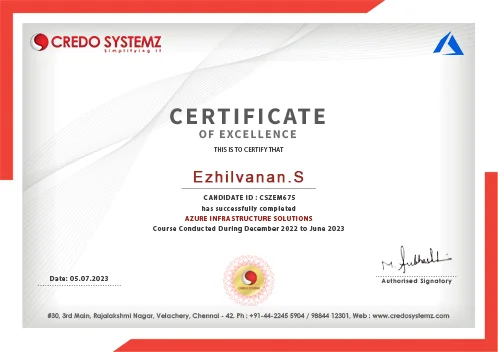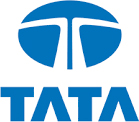Skip to content
Hello, welcome to my blog!
Why Choose a Azure Infrastructure course from Credo?
To expertise in Azure Infrastructure Solutions, Join Credo Systemz Azure Infrastructure Solutions Training in Chennai. This Azure Infrastructure Solutions Course in Chennai assists in acquiring the industrial skills of Azure Infrastructure Solution. Gain proficiency in the Azure Infrastructure Solutions platform using Practical Training. Our Azure Infrastructure Solutions Training is framed from scratch to cope with the market demand.
Find out what our past customers have to say about credo and their experiences with us
Azure Infrastructure Solutions Training Curriculum
Credo Systemz Azure Infrastructure Solutions course in Chennai aims at providing the standard curriculum from scratch. This Azure Infrastructure Solutions course covers the necessary modules using industrial professionals.
Download curriculum
Azure Infrastructure Solutions Course Content
Module I – Create and Manage Azure Resource Manager Virtual Machines
Deploy workloads on Azure Resource Manager (ARM) virtual machines (VMs)
Angular- Definition
Identify workloads that can and cannot be deployed run workloads that use Microsoft or Linux operating systems;
Create VMs; connect to a Windows/Linux VM;
Deploy workloads; deploy Bring Your Own License (BYOL) images Perform configuration management
Automate configuration management by using PowerShell Desired State Configuration (DSC) and VM Agent (custom script extensions);
Enable remote debuggingDesign and implement VM storage
Configure disk caching & plan storage
Configure operating system disk
Configure shared storage using Azure File service & Azure File Share
Configure geo-replication. Encrypt
Implement ARM VMs with Standard and Premium
Configure Blob-Level Tiering (Hot, Cool, Archive). Manage storage encryption keys Monitor ARM VMs
Configure ARM VM monitoring; configure alerts.
Configure diagnostic and monitoring storage location Manage ARM VM availability
Configure multiple ARM VMs in an availability set for
Configure each application tier into separate availability
Combine the Load Balancer with availability
Configure fault domains and update
Leverage Availability Zones Scale ARM VMs
Scale up and scale down VM
Deploy ARM VM Scale Sets (VMSS).
Configure ARM VMSS auto-scale.
Module II – Design and Implement a Storage Strategy
Implement Azure Storage blobs and Azure Files
Identify appropriate blob type for specific storage
Read data, change data ,set metadata on a
Store data using block and page blobs & stream data using blob
Access blobs securely & implement async blob
Configure Content Delivery Network (CDN).
Design blob hierarchies; configure custom
Scale blob storage; manage SMB file storage; implement Azure StorSimple Manage access
Create and manage shared access
Use stored access policies & regenerate
Encrypt keys by using Azure Key Vault integration Implement storage encryption
Encrypt data as written to Azure Storage by using Azure
Storage Service Encryption (SSE).
Implement encrypted and role-based security for data managed by Azure Data Lake
Module III – Implement Virtual Networks
Configure virtual networks
Deploy a VM into a virtual
Configure external and internal load
Implement Application Gateway & design
Configure static, public, and private IP
Set up Network Security Groups (NSGs), DNS at the virtual network level, HTTP and TCP health probes, public IPs, User Defined Routes (UDRs), firewall rules, and direct server
Connect VNets by virtual network Design and implement multi-site or hybrid network connectivity
Choose the appropriate solution between Azure ExpressRoute, site-to-site, and point-to-site.
Choose the appropriate
Identify supported devices and software VPN
Identify networking prerequisites, configure virtual networks and multi-site virtual
Implement virtual network peering and service
Implement hybrid connections to access on-premises data sources, leverage S2S VPNs to connect to on-premises
Monitor
Configure ARM VM networking
Configure static IP addresses, Network Security Groups (NSGs), DNS, User Defined Routes (UDRs), external and internal load balancing with HTTP and TCP health probes, public IPs, firewall rules, and direct server
Design and implement Application
Configure Accelerated
Configure virtual network service
Design and implement a connection strategy
Implement Hybrid Connections to access data sources on-premises; leverage S2S VPN to connect to an on-premises infrastructure
Module IV – Design and Deploy ARM Templates
Implement ARM templates
Author ARM
Create ARM templates to deploy multiple ARM Resource Providers resources of different types with count loops and Marketplace
Deploy templates with PowerShell, Azure CLI, Azure Portal and REST API
Control access
Leverage service principals with ARM
Use Azure Active Directory Authentication with
Set management
Configure lock
lock
Design role-based access control (RBAC)
Secure resource scopes such as the ability to create VMs and Azure Web
Implement Azure RBAC standard
Design Azure RBAC custom
Module V – Manage Azure Security and Recovery Services
Manage data protection and security compliance
Create and import encryption keys with Key
Automate tasks for SSL/TLS
Prevent and respond to security threats with Azure Security
Configure single sign-on with SaaS applications using federation and password based authentication.
Add users and groups to
Revoke access to SaaS
Configure
Configure federation with public consumer identity providers such as Facebook and
Implement recovery services
Create a backup
Deploy a backup agent; backup and restore data, use snapshots and Geo-replication for
Implement DR as
Deploy Azure Site Recovery (ASR) agent, configure ASR; configure ASR one-click failover
Module VI – Manage Azure Operations
Enhance cloud management with automation
Implement PowerShell
Integrate Azure Automation with Web
Create and manage PowerShell Desired State Configurations (DSC).
Import DSC resources; generate DSC node configurations; monitor and automatically update machine configurations with Azure Automation
Implement serverless computing, including Azure Functions, Event Grid, and Service Bus
Collect and analyze data generated by resources in cloud and on-premises environments
Collect and search across data sources from multiple
Build custom
Visualize Azure resources across multiple
Transform Azure activity data and managed resource data into an insight with flexible search queries; monitor system updates and malware
Track server configuration changes by using Azure Log
Configure the IT Service Management Connector (ITSMC).
Module VII – Manage Azure Identities
Monitor on-premises identity infrastructure and synchronization services with Azure AD Connect Health
Monitor AD FS proxy and web application proxy
Setup email notifications for critical
Generate utilization
Monitor Sync
Monitor domain controllers & monitor replication Manage domains with Azure Active Directory Domain Services
Join Azure virtual machines to a domain, securely administer domain-joined virtual machines by using Group
Migrate on-premises apps to
Handle traditional directory-aware apps along with SaaS apps Integrate with Azure Active Directory (Azure AD)
Implement Azure AD Connect and single sign-on with on-
premises Windows Server
Add custom
Monitor Azure
Configure
Configure Windows 10 with Azure AD
Implement Enterprise State Roaming, implement Azure AD integration in web and desktop applications.
leverage Microsoft Graph
Implement Azure Managed Service Identity; implement Privileged Identity Management, implement Azure AD Identity Management, enable self-service password
Chapter 8: Directives & Custom Directives
Directives – Introduction.
Component VS Directives
What are the Different kind of Directives available in Angular?
Difference between Structural & Attribute Directives.
Overview of All Structural & Attribute Directives.
– ngIfDifference between ngIf & hidden directives.
How to create Custom Directives? @Directive Decorator and its Meta data properties.
How to pass Input property to the custom directive?
How to receive Input property from the outside of the directive?
@Input decorator and its methods.
What is ElementRef and its purpose? @HostListner decorator overview. Chapter 9: Pipes in Angular
What is Pipe in Angular?
what are the purpose of the Pipes?
Difference between Pipes & Directives.
Detailed explanation of the below Pipes,
What is Pure Pipe & Impure Pipe?
How to create Custom Pipes?
What is chaining Pipes?
What is Parameterized Pipe? Chapter 10: Components Communication
Overview of Components Interaction.
Share data between components by using Service.
Component Interaction from Parent to Child.
Component Interaction from Child to Parent.
@ViewChild decorator overview
@Input & @Output decorator overview
Define Custom Event Binding
Components Interaction by using Event Emitter & Subject and observable Chapter 11: Event Emitter and other special Directives
What is Event Emitter?
When to use Event Emitter?
How to transfer data with Event Emitter?
How to create Custom Events and Trigger?
OverView Encapsulation
What is ng-content and its purpose?
ng-container Directive overview. Chapter 12: Template Driven Form in Angular
Template Driven Form
Purpose of Form in Angular.
How to setup a form in Angular?
What is form control and how to set it?
Define ngForm
How to Access form values?
What are the form states available in Angular?
TD form Validations.
HTML5 Validation vs Angular form Validation.
How to set prepopulate values in form fields?
Setup One-way data binding in Angular. Chapter 13: Reactive Form in Angular
What is Reactive Form?
Difference between Template Drive & Reactive Form
What is form group & form control?
How to sync view & Reactive form TS?
What is Patch Values & Set Values?
How to attach Dynamic Validations?
How to get Reactive from Values?
Create Dynamic Form by using Reactive Form Chapter 14: Service and Dependency Injection in Angular
Service in Angular
Create & configure Service in Angular.
How to do Dependency Injection in Angular?
Define Singleton Object
Multiple DI in single Class. Chapter 15: Routing in Angular
What is Routing?
How Routing makes our App into SPA?
How to configure Routing in an Application?
Load our components dynamically based on url path.
How to create Child Route?
Navigating to other links programmatically.
Passing Parameter to the Routes.
Static Route vs Dynamic Route.
Define Fetching Route Params.
Router Directives overview
Client-side authorization using Route Guard
Chapter 16: HTTP & Observable in Angular
HTTP Client in Angular.
REST API – Overview
How to establish HTTP request to Server side.
How HTTP Mechanism works?
What are the methods available in HTTP?
Define Observable & Observer
What are the call back methods available in Observable?
Creation of a Custom Observable
Define next(), error() and complete()
How to send Query Params & Custom Headers?
How to connect any backend & APIs?
Define CORS
How to resolve CORS errors?
Chapter 17: Authorization in Angular & JWT
Client side Authorization vs Server side Authorization.
Server side Authorization by using JWT Token.
Set JWT Key Expiry time.
HTTP interceptors – Overview.
How to configure HTTP interceptors?
Chapter 18: File Upload in Angular
Angular form setups for File Upload.
FormData() in Angular
Server side setups for File Upload.
Multer NPM in Node.
How to use Multer NPM as middleware in Node?
Attach the Multer middleware in server-side routing.
Chapter 19: Real-time Project in Angular
During the course we will take one Real-time E-commerce application and apply all the above sections into the project. In the project Front-end will be in Angular and Back-end will be in Node JS. On top of the Node JS we will write Express JS as a REST Api. For Database, we choosed MongoDB for CURD Operations.
View More
Flexible Mode of Training and Payment
Hear it from our customer!!
Our Azure Infrastructure Solutions Training Overview
Our Azure Infrastructure Solutions Certification training in Chennai assists in Professional skills development using hands-on practices. Attend Our Azure Infrastructure Solutions Training Demo to experience the live training sessions.
Azure Infrastructure Solutions Training Hands-on training
Detailed instructor led sessions to help you become a proficient Expert in Azure Infrastructure Solutions Training.
Build a Azure Infrastructure Solutions Training professional portfolio by working on hands on assignments and projects.
Personalised mentorship from professionals working in leading companies.
Lifetime access to downloadable Azure Infrastructure Solutions Training course materials, interview questions and project resources.
Training Benefits!!
To master Azure Infrastructure Solutions, Get Professional support at Credo Systemz Azure Infrastructure Solutions Training in Chennai. Using professional trainers, this Azure Infrastructure Solutions Course assists in gaining industrial experience. This Azure Infrastructure Solutions Training offers 100% practical training with live sessions.
5-15%
5-15% Chances of immediate placements.
10-15%
10-15% increase in salary.
~30%
30% of job market is open.
Testimonials
completed the Azure Infrastructure Solutions training in Chennai at Credo Systemz. This Azure Infrastructure Solutions Course aims at gaining the in-built knowledge using best trainers. The Trainer provides Practical training sessions using projects and practices.
Nandhini
Credo Systemz offers Real time Azure Infrastructure Solutions training sessions with a wide range of practices. I acquired the essential skills of Azure Infrastructure Solutions using professional trainers. Thanks to Credo Systemz.
Prasanna
Join Us
CREDO SYSTEMZ provides the Best Angular Training in Chennai to promote you into a skilled angular professional with 100% Free Placement Support.
Join Now
Azure Infrastructure Solutions Course FAQs
What are your payment terms?
No hurries!! Credo Systemz allows you to select your preferred payment via Cash, Card, Cheque and UPI services.
Are you looking for exciting offers or concessions or group discounts?
Why Should I enroll at Credo Systemz Microsoft Azure Infrastructure Solutions Training?
Credo Systemz offers the Best Practical based Microsoft Azure Infrastructure Solutions Training in Chennai. Our Trainers are experienced Azure professionals who assist in acquiring the skills to upskill the Azure career. We offer:
Industrial standard Curriculum
Interactive, Real Time Training
Expert trainers and support team
Job Ready skills and knowledge
Hands-on practices and live projects
Certification and placement Support
How do I schedule a free demo class and how is it helpful?
Our free demo classes are very useful to understand our Microsoft Azure Infrastructure Solutions course. It provides a clear picture about
Azure Infrastructure Solutions curriculum and course plan.
Practical oriented classes and to Interact with the trainers.
What are your payment terms for this Azure Infrastructure Solutions course?
No hurries!! Credo Systemz allows you to select your preferred payment. In this AWS Solution Architect Course, We ensure affordable course price using Cash, Card, Cheque and UPI services.
What if I miss a training session ?
You can attend your missed sessions with upcoming Azure Infrastructure Solutions Course batches. Our admin team arranges a compensation session within the batch or the next available batch. Also, we provide a recorded video of our live session for your reference.
For More Queries ?
Our Alumni Work in top MNC’S
Credo Systemz has placed thousands of students in various top multinational organiation,
witnessing the progress of our alumni gives us immense gratification.
Join the success community to build your future
Enroll now
Get Industry Recognized Certification
Credo Systemz’s certificate is highly recognized by 1000+ Global companies around the world.Credo Systemz’s Azure Infrastructure Solutions certification shows the skill set of the aspirants with global recognition.
Benefits of Azure Infrastructure Solutions Certification
To demonstrate the Proficiency of Azure Infrastructure Solutions.
To add weightage to your Professional cloud resume.
To enhance your credibility in using Azure Infrastructure Solutions.














